Do you need to know how to check 240 volts with a multimeter? If so, you’re in the right place! In this blog post, we will teach you everything you need to know about checking the voltage on appliances and other devices. We will also provide some tips on how to stay safe while doing this. So, whether you’re a homeowner or a professional electrician, read on for all the information you need!
What is a Multimeter?
A multimeter is a device that can be used to measure current, voltage, and resistance. It is a handy tool to have around the house for electrical projects or for testing voltage.
In addition, a multimeter can also be used to test for continuity. Continuity is the ability of an electrical circuit to allow current to flow freely.
There are 2 types of multimeters: digital and analog.
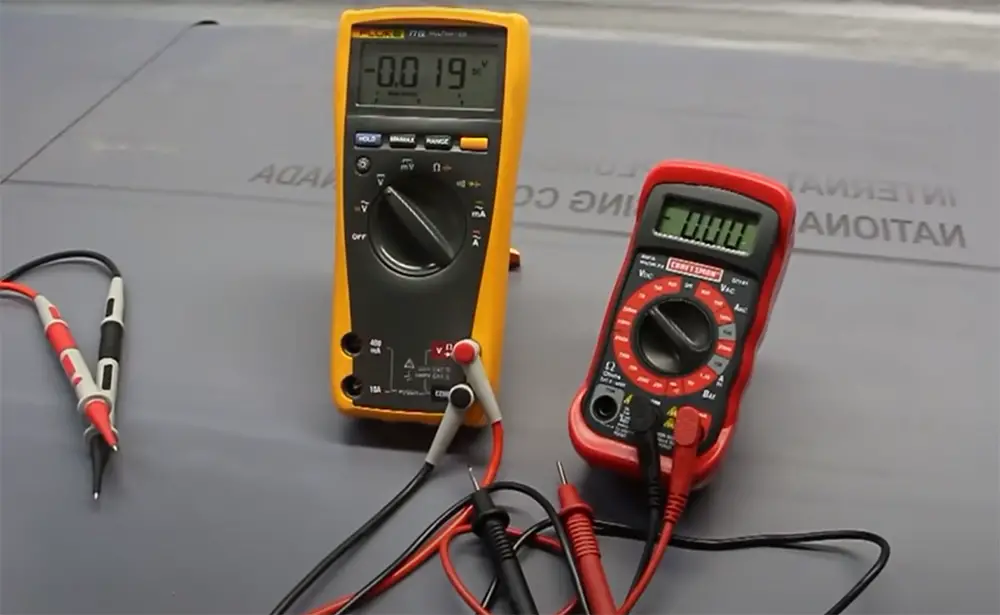
- Digital multimeters are more accurate than analog ones and are easier to read. In addition, digital multimeters typically have more features than analog ones. However, they are also more expensive.
- Analog multimeters use a needle to indicate readings on a scale, while digital multimeters display readings on a digital screen. In addition, analog multimeters can be more difficult to use than digital multimeters. However, they are cheaper.
If you are new to using a multimeter, it is best to start with a digital one.
Sometimes, you may need to use a multimeter in combination with another tool, such as a voltmeter, to get accurate readings.
There are some additional features that you may find on a multimeter, such as a backlight, which makes it easier to read in low-light conditions.
Checking 240 Volts Using A Multimeter
Now that you have your multimeter, it’s time to check the voltage in your home.
What you will need:
- A multimeter
- An extension cord (optional)
- An assistant (optional)
- First, unplug any appliances from the outlet you’ll be testing. It’s important to do this because you don’t want to shock yourself. If the outlet is in a hard-to-reach place, you may need an extension cord to plug the multimeter into. Locate your circuit breaker box and make sure the power is turned off to the outlet you’ll be testing
- Next, set your multimeter to the “AC voltage” setting. Most have a specific slot for this, but if yours doesn’t, consult the manual. It is important that you do not use the “DC voltage” setting, as this can damage your multimeter.
- Then, touch the probes to the screws on either side of the outlet. To do this, you may need to remove the outlet cover. To do this, simply unscrew the screws that are holding the faceplate in place. Once the faceplate is removed, you will see the wires that are connected to the outlet.
- There should be two screws on either side of the outlet, one for the “hot” wire and one for the “neutral” or “return” wire. The “hot” wire is usually brass-colored, while the neutral wire is silver. Touch one probe to each of these screws and make sure that the reading on your multimeter says 240 volts.
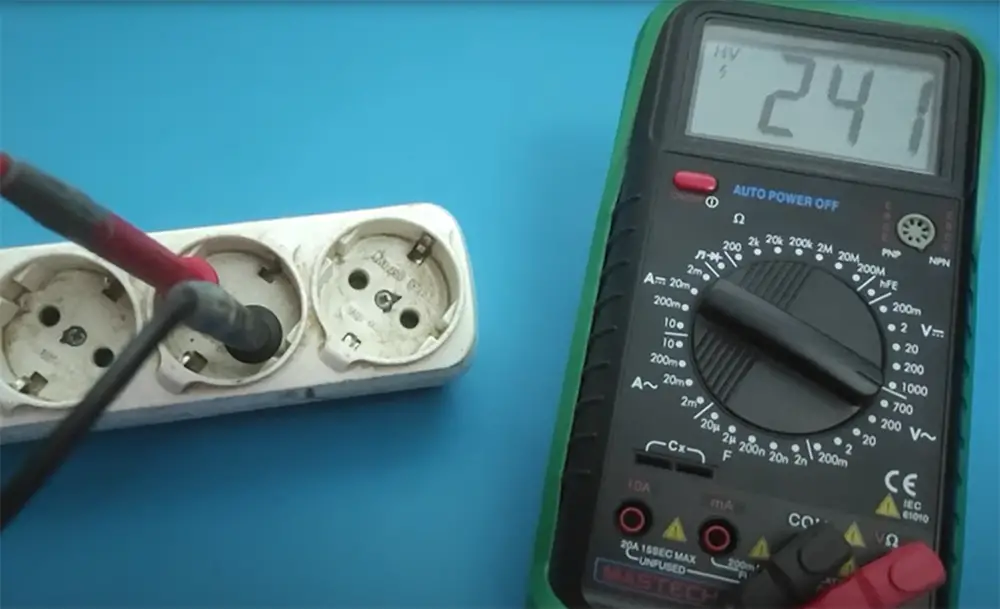
If you have an assistant, they can hold onto one of the probes while you touch the other one to each of the screws. This will allow you to get a more accurate reading. [1]
- If you don’t get a reading, try flipping the breaker back on and then off again. This should reset the circuit and you should get a reading. If it doesn’t, there may be a problem with the outlet or the wiring in your home and you’ll need to call an electrician. If the reading on the multimeter says “0,” this means there is no power running to the outlet and it is safe to proceed.
- You should also check neutral and ground wires. It is essential to make sure that the ground wire is properly connected, as this protects you from shocks. To test the ground wire, touch the probes to the metal box that houses the outlet (if it’s not plastic) or to the green “ground” screw on the side of the outlet. The reading should say 0 volts.
- Once you have verified that the outlet has 240 volts, you can replace the faceplate and screw it back into place. Then, turn the power back on at the circuit breaker box. You’re now ready to plug your appliances back in and use them!
What is the voltage standard and why do we need to check it?
The voltage standard is the maximum amount of voltage that can be safely supplied to an electrical device. This is typically expressed in volts (V).
In the United States, the voltage standard is 120 V. However, in some parts of the world, the voltage standard is 240 V. For this reason, it’s important to check the voltage before plugging in an electrical device. [1]
One more reason to check the voltage is that some devices can’t handle 240 V. If you plug in a device that can only handle 120 V into a socket with 240 V, it will likely get damaged. To avoid this, you can use a multimeter to check the voltage of an outlet before plugging in a device.
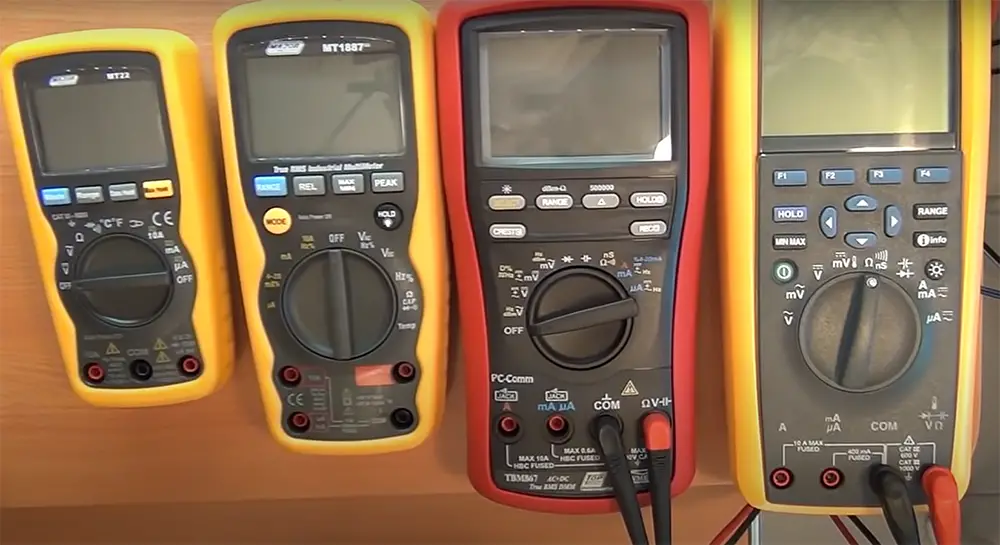
In addition, some devices are designed to work with both 120 V and 240 V. For example, hair dryers and curling irons typically have a switch that allows you to choose the voltage.
If you’re not sure what voltage an outlet is, it’s always best to err on the side of caution and check it with a multimeter before plugging anything in.
Other ways to Check 240 Voltage
If you do not have or do not want to buy a multimeter, there are other ways that you can check the 240-volt outlet.
- First option: You can use a circuit tester. Circuit testers are inexpensive and can be found at most hardware stores. To use the circuit tester, simply touch one lead to the hot (black or red) wire and the other lead to the grounding screw or bare copper wire in the outlet box. If the circuit is live, the tester will light up or make a sound.
- Second option: Another way to check the voltage is to use a voltmeter. A voltmeter is more accurate than a circuit tester and can be found at most hardware stores. To do this, you will need to turn off the power to the outlet at the main breaker panel. Once the power is off, follow the same instructions as for a circuit tester. If there are 240 volts present, then you will see a reading on the voltmeter.
- Third option: If you have another 240-volt appliance, such as a dryer or range, you can plug it into the outlet and see if it powers on. If it does, then you know that the outlet is providing 240 volts.
- Fourth option: You can also hire an electrician to test the outlet for you. This is the most accurate way to test the voltage, but it is also the most expensive. He/she will use a voltmeter or a multimeter to test the voltage and will also be able to tell if there are any other problems with the outlet.
Keep in mind that you should always use caution when working with electricity. If you are not comfortable working with electricity, then it is best to hire a qualified electrician to do the work for you [2].
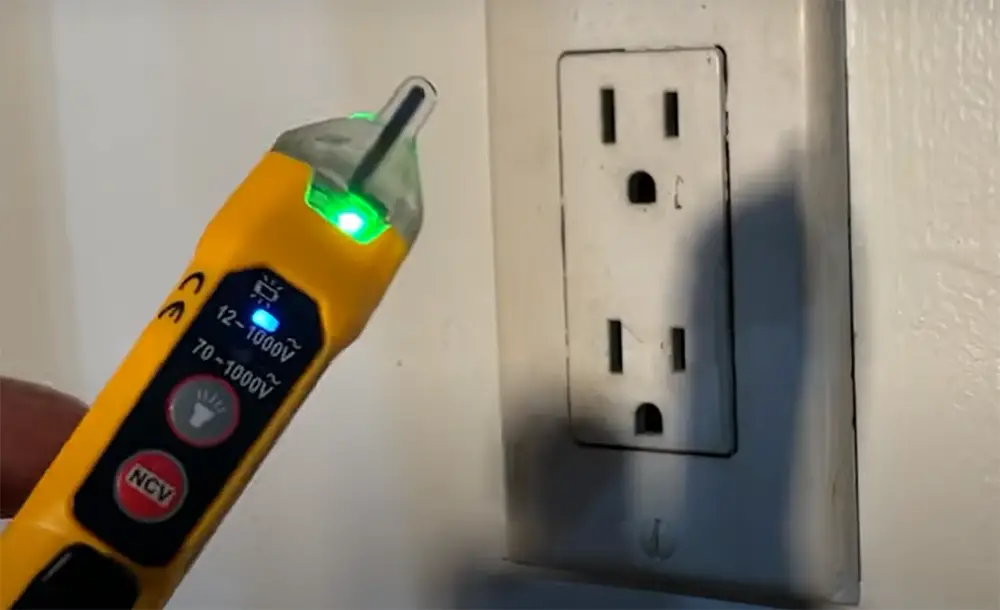
Safety first
You should always take precautions when working with electricity. Make sure you have a clear understanding of what you’re doing before proceeding. If you’re unsure about anything, don’t hesitate to ask a qualified electrician for help.
- Turn off the power to the outlet before testing – It’s important to make sure that the power is off before testing. Otherwise, you could risk getting electrocuted.
- Don’t touch anything metal – Once the power is off, you should avoid touching anything metal. This includes the multimeter itself. If you must touch metal, make sure you’re not standing on a wet surface.
- Test the multimeter – Before testing the outlet, it’s a good idea to test the multimeter itself. This will help ensure that it’s working properly.
- Use one hand only – If possible, use just one hand when working with electricity. This will help prevent you from getting shocked if something goes wrong.
- Never stick anything into an electrical outlet while it’s plugged in – This is a surefire way to get electrocuted. Even if the power is off, it’s still not safe to stick anything into an outlet.
- Test each outlet individually so you don’t accidentally shock yourself – It’s important to test each outlet individually. Otherwise, you could accidentally shock yourself if you touch a live wire.
- Wear rubber-soled shoes – Rubber-soled shoes will help protect you from shocks. For example, if you’re standing on a wet surface, you’ll be less likely to get shocked if you’re wearing rubber-soled shoes.
- Wear gloves and avoid bare skin – Wearing gloves and avoiding bare skin will also help protect you from shocks.
- Use the proper setting on your multimeter – Be sure to use the proper setting on your multimeter. Otherwise, you could get inaccurate results.
- Be careful not to drop the multimeter – Dropping the multimeter could damage it and cause it to give inaccurate readings. Moreover, it could also pose a safety hazard if it falls on someone.
- Use eye protection – It’s always a good idea to use eye protection when working with electricity. This will help protect your eyes from sparks and other dangers.
- Follow the manufacturer’s instructions – Be sure to follow the manufacturer’s instructions when using the multimeter. Otherwise, you could damage it or void the warranty.
If you follow these safety precautions, you’ll be able to safely check the voltage of an outlet using a multimeter. Just remember to always err on the side of caution when working with electricity.
Tips
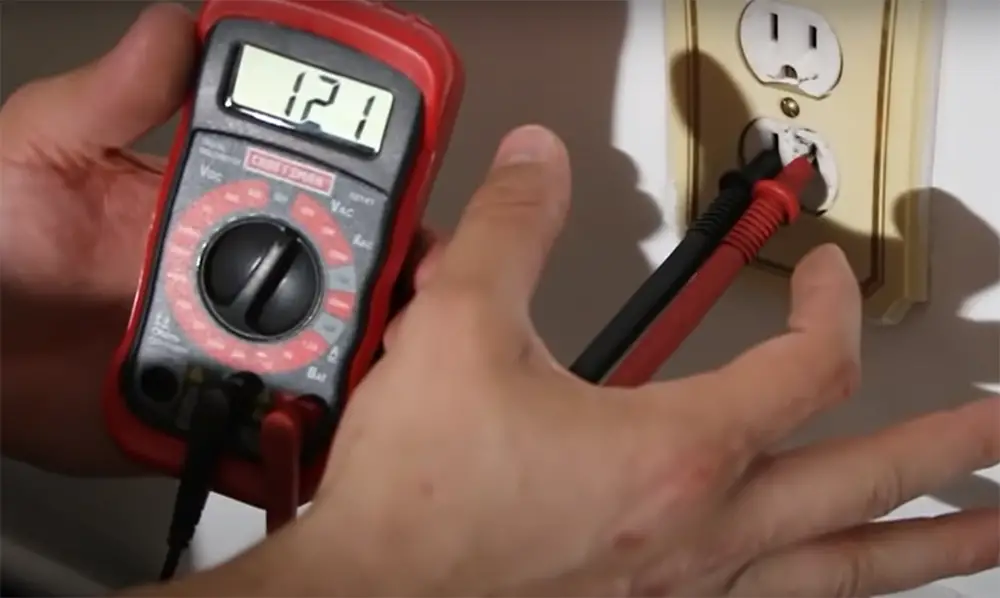
Here are some more tips on using a multimeter:
- Check the voltage at the outlet with a multimeter before plugging in your appliance. This will help you determine if the outlet is receiving power.
- Always use caution when working with electricity. If you are unsure of what you are doing, always seek professional help.
- When using a multimeter to check voltage, be sure to set it to the correct setting. Most multimeters have a setting for AC or DC voltage.
- Be sure to test both the hot and neutral wires when checking for voltage. The hot wire is usually colored black or red, while the neutral wire is usually white.
- If you are testing for voltage in an outlet, be sure to plug the multimeter into the outlet before turning on the power. This will help prevent damage to your multimeter.
- Always turn off the power before disconnecting your appliance from an outlet. This will help prevent electrocution.
- If you are unsure about the reading, take an average of several readings. This will help ensure accuracy.
- When taking voltage readings, always write down the exact reading. This will help you keep track of the results.
- Remember to always use safety goggles.
- Be careful when handling the multimeter probes.
FAQ
How do you know if it’s 120 or 240 volts?
The easiest way to determine whether a circuit is 120 or 240 volts is to look at the breaker panel. If the circuit breaker is labeled as “120/240” then it’s safe to assume that the voltage in the circuit is 240 volts.
If you don’t have access to the breaker panel, another way to check is to use a multimeter.
How many wires is 240?
240-volt circuits have two “hot” wires that each carry 120 volts. The wires are usually colored black and red, but other colors are also used.
In addition to the two hot wires, there will also be a neutral wire (usually white) and a ground wire (usually green or bare copper).
So in total, there are four wires in a 240-volt circuit.
Is 220 the same as 240?
No, 220 and 240 volts are not the same. 220 volts is actually just a nickname for 230 volts, and 240 volts is a nickname for 250 volts.
The difference may seem small, but it’s actually quite significant. For example, a 240-volt appliance will not work on a 220-volt circuit.
Useful Video: How to check a 240-Volt Outlet for Voltage
Final Thoughts
Testing 240-volt circuits is a delicate task. You’re dealing with high voltage, so it’s important to be extra careful. But as long as you take the proper precautions and follow the steps outlined in this article, you should be able to test 240-volt circuits without any problems. Always exercise caution and consult a professional if you are unsure about anything.
Now you know how to check 240 voltage with a multimeter! So go out and test those circuits!
Do you have any tips on how to check 240 volts with a multimeter? Did this article help you out? Let us know in the comments below! And be sure to check out our other articles on electrical testing for more information.
If you’re looking for more information on electrical testing, be sure to check out our other articles. We have tons of resources that can help you out. Thanks for reading!
Check out our other articles on electrical testing! We have tons of resources that can help you out. Thanks for reading!
References:
- https://electrouniversity.com/how-to-check-240-voltage-with-a-multimeter/
- https://www.quora.com/How-do-I-check-the-voltage-of-240v-AC-with-a-multimeter





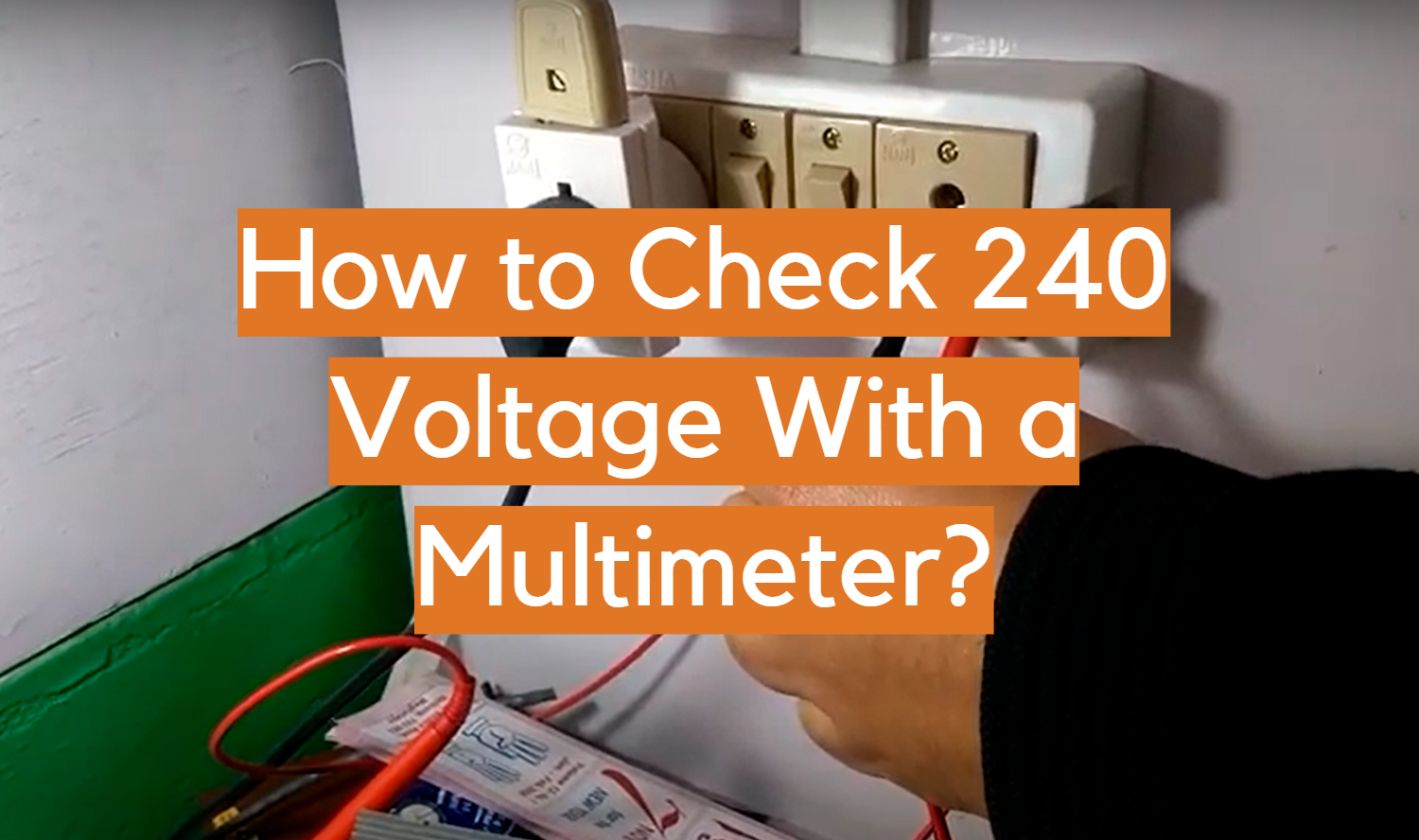
 In my perspective, understanding voltage standards is crucial for safe electrical device operation. Varying standards worldwide, like 120 V in the US and 240 V elsewhere, underscore the need for voltage checks before plugging in devices. Mismatching voltage requirements can lead to costly damage, making a multimeter a handy tool for voltage verification and peace of mind.
In my perspective, understanding voltage standards is crucial for safe electrical device operation. Varying standards worldwide, like 120 V in the US and 240 V elsewhere, underscore the need for voltage checks before plugging in devices. Mismatching voltage requirements can lead to costly damage, making a multimeter a handy tool for voltage verification and peace of mind.







Leave a Reply